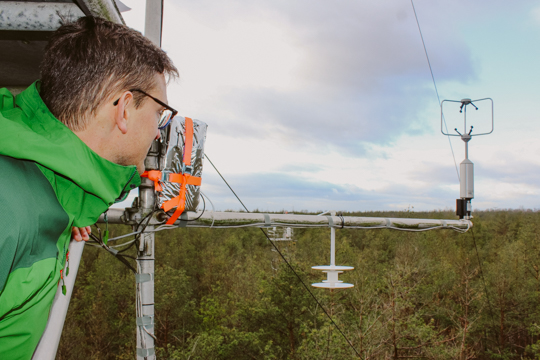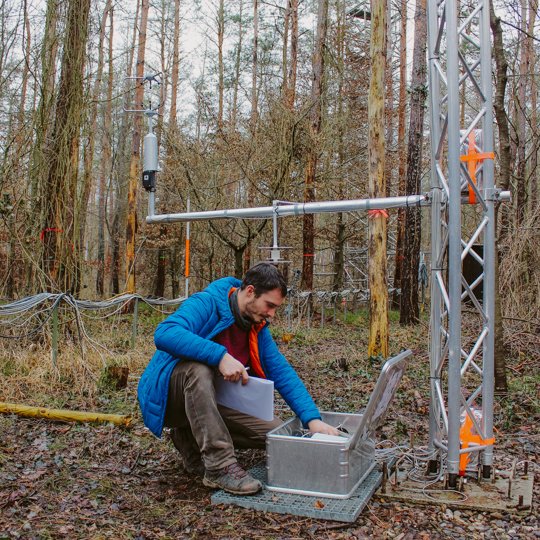Eddy-fying Research
Freiburg, May 04, 2020
Using new measuring instruments and methods, Freiburg researchers want to detect fluctuations in near-surface airflow, so as to study its influence on the exchange rates of greenhouse gases. Prof. Dr. Dirk Schindler of the Chair of Environmental Meteorology developed this approach together with his team. Presenting a series on research projects and departments for the 50th anniversary of the Faculty of Environment and Natural Resources (UNR): Part three – “Air” – expands on a newly-discovered phenomenon: pressure pumping.
 The forest could become more important to climate protection: Dirk Schindler’s findings indicate that soil can absorb more methane as a result of pressure pumping. Photo: lily/stock.adobe.com
The forest could become more important to climate protection: Dirk Schindler’s findings indicate that soil can absorb more methane as a result of pressure pumping. Photo: lily/stock.adobe.com
For six years Dirk Schindler has been studying how fluctuations in near-surface airflow affecting the forest floor influence the exchange rates of greenhouse gases such as carbon dioxide and methane between the forest and the atmosphere. He has devoted himself to a topic that has barely been researched anywhere else in the world – yet it could enable us to determine the contribution of forest soil to climate protection more precisely. His current project, which is funded by the German Research Foundation (DFG), is called “Do wind-induced pressure fluctuations contribute to methane oxidation in aerated soil?” Alongside Schindler, the core team consists of another employee from his department and two employees from the Soil and Environment department at the Forest Research Institute Baden-Wuerttemberg (FVA).
The exchange between above-ground and below-ground
“In the struggle against the impact on the climate, we need to know more about how forests perform and understand as many processes as possible,” explains Schindler. “So we’re analyzing how atmospheric turbulence, that is: air vortices, influence near-surface methane exchange. Amongst other things we’re measuring whether there is a greater quantity of the gas in this area after strong gusts,” says the forestry scientist.
It has already been scientifically proven that powerful air vortices that occur above forests increase the exchange rates between the above-ground elements of the forest ecosystem and the atmosphere. This is caused by wind speeds differing between the airflow over the forest and within it. Since air pressure fluctuations occur directly above the Earth’s surface but there is hardly any airflow, experts hadn’t previously associated the effects of air vortices with the size of the rate of gas transport into the soil.
 Twenty-one meters above ground: Dirk Schindler stands on one of the five measuring towers which record wind speed around the clock. Photo: Dirk Schindler
Twenty-one meters above ground: Dirk Schindler stands on one of the five measuring towers which record wind speed around the clock. Photo: Dirk Schindler
“Field trials with strong winds have however yielded up to 30 percent higher rates of gas transport into the topsoil. This questions previous assumptions,” says Schindler. “We traced these results back to air pressure fluctuations immediately next to the soil, which in turn have occurred as a result of atmospheric turbulence.” His theory is that the increase and decrease in air pressure forces gases into or draws them out of the air-filled pores in the soil. The process is called “pressure pumping”, and it involves atmospheric air pressure fluctuations spreading in the Earth’s surface and increases the exchange rates between it and the atmosphere. “If forest soil can absorb a greater quantity of methane, which is very harmful to the environment, its potential in the exchange of greenhouse gases and thus contribution to climate protection has to be reassessed,” Schindler points out.
24/7 measurement
At the start of the project Dirk Schindler faced a massive challenge: conventional measuring instruments and methods were unable to record the extremely small air pressure fluctuations. “Working with the Chair of Soil Ecology at Freiburg University we developed an innovative measuring process and more sensitive sensors in order to be able to record the processes and their influence at all,” he explains. “This has enabled us to record air pressure fluctuations of a few tenths of a Pascal very precisely under field trial conditions. That’s air pressure fluctuations one million times smaller than the average atmospheric air pressure at sea level.” Since 2015 the sensors have been in use in a good dozen different sites.
This year the researchers want to measure for the first time how air pressure fluctuations spread three-dimensionally. So five 21 meter high meteorological measuring towers have been constructed on a 4,900 m² area of Freiburg University’s forest meteorological station in the Hartheim local forest. The towers are equipped in total with 20 measuring devices that record wind speed. At the same time 80 sensors in and above the forest floor measure air pressure. They work at a frequency of 10 Hertz, so that each sensor provides 36,000 data within an hour. Measurements are taken 24 hours a day, seven days a week. “We programmed an algorithm specially for the project, which can analyze these massive amounts of data for us,” says the scientist.
 The Freiburg team’s new measuring instruments are being used in a forest near Hartheim. Photo: Dirk Schindler
The Freiburg team’s new measuring instruments are being used in a forest near Hartheim. Photo: Dirk Schindler
Researching pressure pumping worldwide
So far, it’s been possible to prove the process of pressure pumping at all the sites and increase the rate of gas transport in well-aerated soils by up to 30 percent. The scientists speculate that this increases the consumption of methane in the soil, because the oxygen supply to microorganisms living there improves. “We’ve been able to derive these positive interim results from the measuring campaigns so far.”
The team will take measurements at the test area and continue to improve the method until late summer. After that the test setup will be expanded to take in other FVA sites. What happens if similar effects are confirmed at all measuring points? “Then we could adapt our method to the requirements of other measuring stations and research pressure pumping worldwide.”
Dirk Schindler is more than satisfied with the response from the scientific community. Although it’s relatively small, the exchange of ideas is all the more lively. National and international colleagues are especially interested in the measuring method and the scope of the measuring campaigns in the project. “With our fundamental research we’re not only improving the quantification of flows of substances. Rather, we’re creating new knowledge and closing gaps in our understanding of the exchange of greenhouse gases.” In view of climate change, the importance of forest soil and need to protect it, as well as other agricultural areas, could increase still more.
Kristin Schwarz
More texts from the series:

